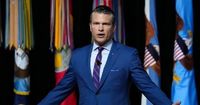In a sweeping set of reforms announced on Tuesday, September 30, 2025, Defense Secretary Pete Hegseth unveiled a dramatic overhaul of U.S. military personnel policies, instituting the strictest physical fitness and grooming standards in decades and mandating gender-neutral requirements for all combat roles. The changes, detailed in several memos issued by the Pentagon and previewed in Hegseth’s address at Marine Corps Base Quantico, Virginia, mark a decisive shift toward what the secretary called a relentless pursuit of combat readiness and lethality.
“From this moment forward, the only mission of the newly restored Department of War is this war fighting,” Hegseth declared to a room packed with senior military leaders. “Preparing for war and preparing to win, unrelenting and uncompromising in that pursuit. Not because we want war — no one here wants war — but it’s because we love peace.” According to USNI News, Hegseth’s remarks set the tone for a series of reforms that will touch every corner of military life, from the barracks to the battlefield.
At the heart of these changes is the introduction of what Hegseth called the “highest male standard” for all combat roles across every service branch. As reported by Nexstar Media, Hegseth told hundreds of generals and admirals, “At my direction, each service will ensure that every requirement for every combat MOS [military occupational specialty], for every designated combat arms position, returns to the highest male standard only, because this job is life or death, standards must be met, and not just met — at every level, we should seek to exceed the standard, to push the envelope, to compete.” He added, “It’s common sense and core to who we are and what we do. It should be in our DNA.”
This approach means that, for the first time since the ban on women in combat roles was lifted in 2015, all candidates—regardless of gender—must meet the same rigorous physical benchmarks previously set for men. Hegseth acknowledged the likely outcome: “If women can make it, excellent. If not, it is what it is. If that means no women qualify for some combat jobs, so be it.” He was quick to point out, however, that “our female officers and NCOs are the absolute best in the world. But when it comes to any job that requires physical power to perform in combat, those physical standards must be high and gender neutral.”
The new policy institutes two annual fitness tests for all service members: the existing service fitness test and a combat field test for those in combat arms positions, or a combat readiness test for non-combat personnel. Reserve and National Guard members will be required to take one annual fitness test tailored to their combat or non-combat designation. For combat arms roles, the service fitness test will be sex-neutral, age-normed, and based on the male standard, with a required minimum average of 70 percent. The Navy and Marine Corps provided exhaustive lists of the specific roles affected, ranging from Sea, Air, Land Operators and Explosive Ordnance Disposal Technicians in the Navy to Infantry Officers, Field Artillery Cannoneers, and Marine Raiders in the Marine Corps. Notably, pilots and submarine or surface warfare sailors are not included under the new combat standards.
Non-combat positions will still have sex-normed and age-normed fitness tests, but these personnel may substitute the combat readiness test if they choose. Body composition standards—measuring height and waist circumference—will continue to be enforced twice yearly, with further guidance expected within 60 days, according to Pentagon memos. High performers on fitness tests may earn limited exemptions, but “high performance does not excuse non-compliance with body composition standards,” as the memo firmly states.
The new standards also bring sweeping changes to grooming requirements. All service members, except in rare cases, must now be clean-shaven. The rules allow neatly trimmed mustaches that don’t extend past the corners of the mouth, but sideburns above the ear and all other facial hair—including beards and goatees—are prohibited. Special operations forces can request exceptions for mission-essential reasons, but must be clean-shaven when deploying to areas with high chemical, biological, radioactive, or nuclear threats. Medical waivers for facial hair, such as those for pseudofolliculitis barbae—a condition disproportionately affecting Black men—will revert to pre-2020 standards, limited to one year and requiring a treatment plan. Permanent conditions may result in administrative separation. Religious accommodations will follow pre-2010 standards, with waivers rarely granted for deployable roles, especially those with chemical or firefighting risks.
“Uniform grooming standards are not about appearance—they are about survivability, interoperability, and mission execution,” the Pentagon memo reads. “Consistent enforcement ensures personnel can operate protective equipment, meet deployment requirements, and support combat and emergency operations.”
Hegseth’s reforms don’t stop at fitness and appearance. He has ordered a 60-day review of all military education and training standards, instructing branch secretaries and the chairman of the joint chiefs to compare current curricula to those in place in 1990. “1990 seems to be as good as a place to start as any,” Hegseth quipped in his speech, referencing his own commission as an infantry officer in 2003. The review will also apply two new frameworks: the “1990 test,” which benchmarks standards against those from that year, and the “E-6 test,” which asks whether changes empower mid-level leaders to focus on the basics of warfighting.
Mandatory training requirements are also being pared back. The Pentagon will relax or remove a host of trainings, including those on cybersecurity, controlled unclassified information, and records management. Privacy Act Training is being eliminated from Common Military Training, and the frequency of training on combating trafficking in persons will be reduced. The memo calls for consolidation of other mandatory trainings, and for training on harmful behaviors to clearly separate prevention from response, with resources and procedures identified.
In another major shift, Hegseth has ordered a 30-day review of the military’s definitions of hazing, bullying, and harassment, arguing that current definitions are “overly broad.” “The definition of toxic has been turned upside down, and we’re correcting that,” he said. “Setting, achieving and maintaining high standards is what you all do. And if that makes me toxic, then so be it.”
Military Equal Opportunity (MEO) and Equal Employment Opportunity (EEO) processes will be streamlined. All complaints must now be handled within 30 days and dismissed if they “lack actionable, credible evidence.” Anonymous complaints are no longer allowed; instead, a confidential reporting option will be available. Mediation will become the first-line response to complaints, and frivolous or knowingly false complaints will be met with accountability. The Pentagon plans to pilot a consolidation of EEO offices and create a dedicated task force, with cases involving senior officers and executives expedited for resolution.
Finally, the “warrior ethos” will extend to civilian employees. Hegseth is calling for a “cultural refresh” that rewards top performers—including with monetary awards—and provides clearer guidance to managers on separating underperformers, as part of a broader modern workforce management initiative.
These reforms, sweeping in scope and unapologetic in their intent, signal a return to what Hegseth and his supporters view as the military’s core mission: preparing for and, if necessary, prevailing in war. As the Pentagon moves to implement these changes, the impact on service members—and the future composition of the U.S. armed forces—will be closely watched both inside and outside the ranks.

